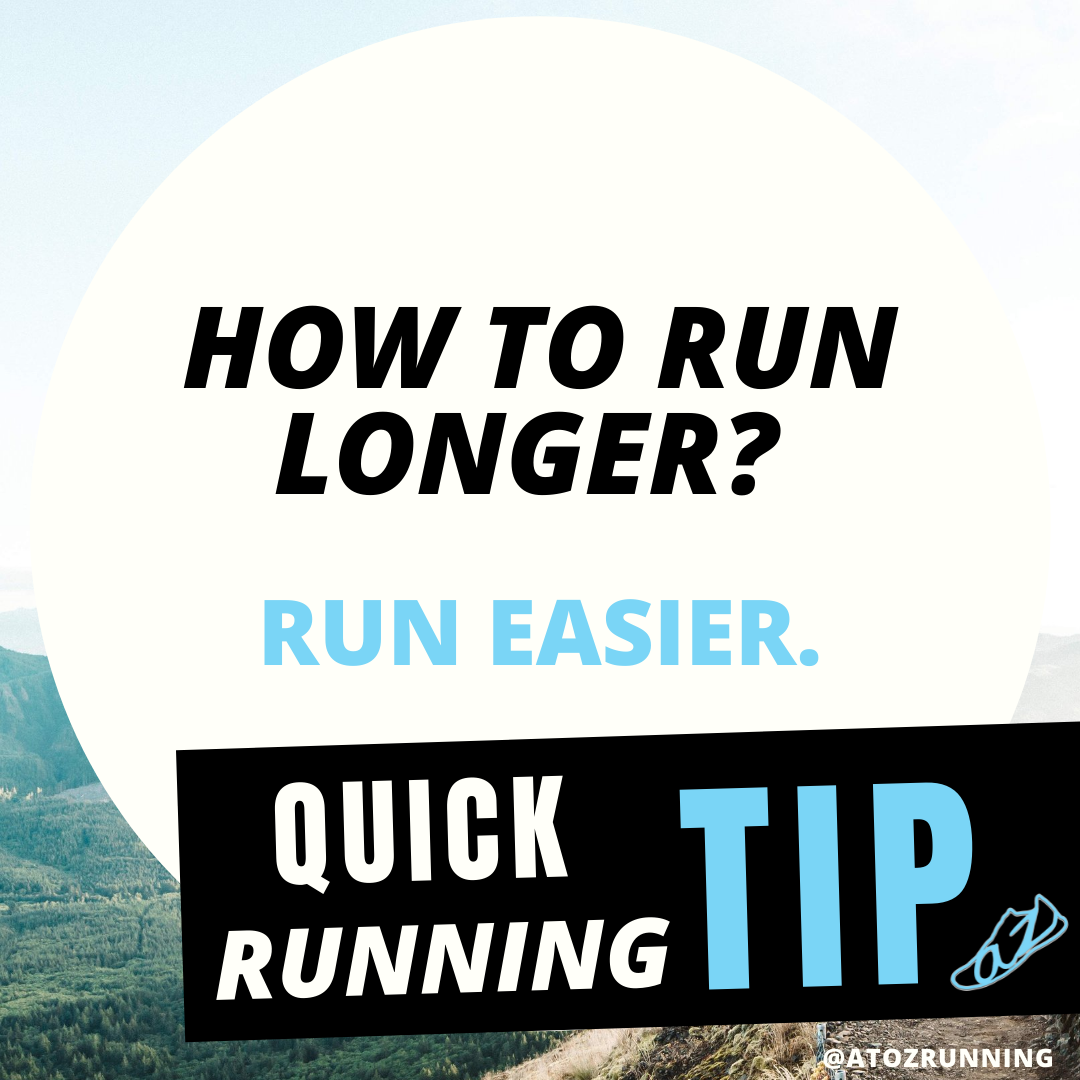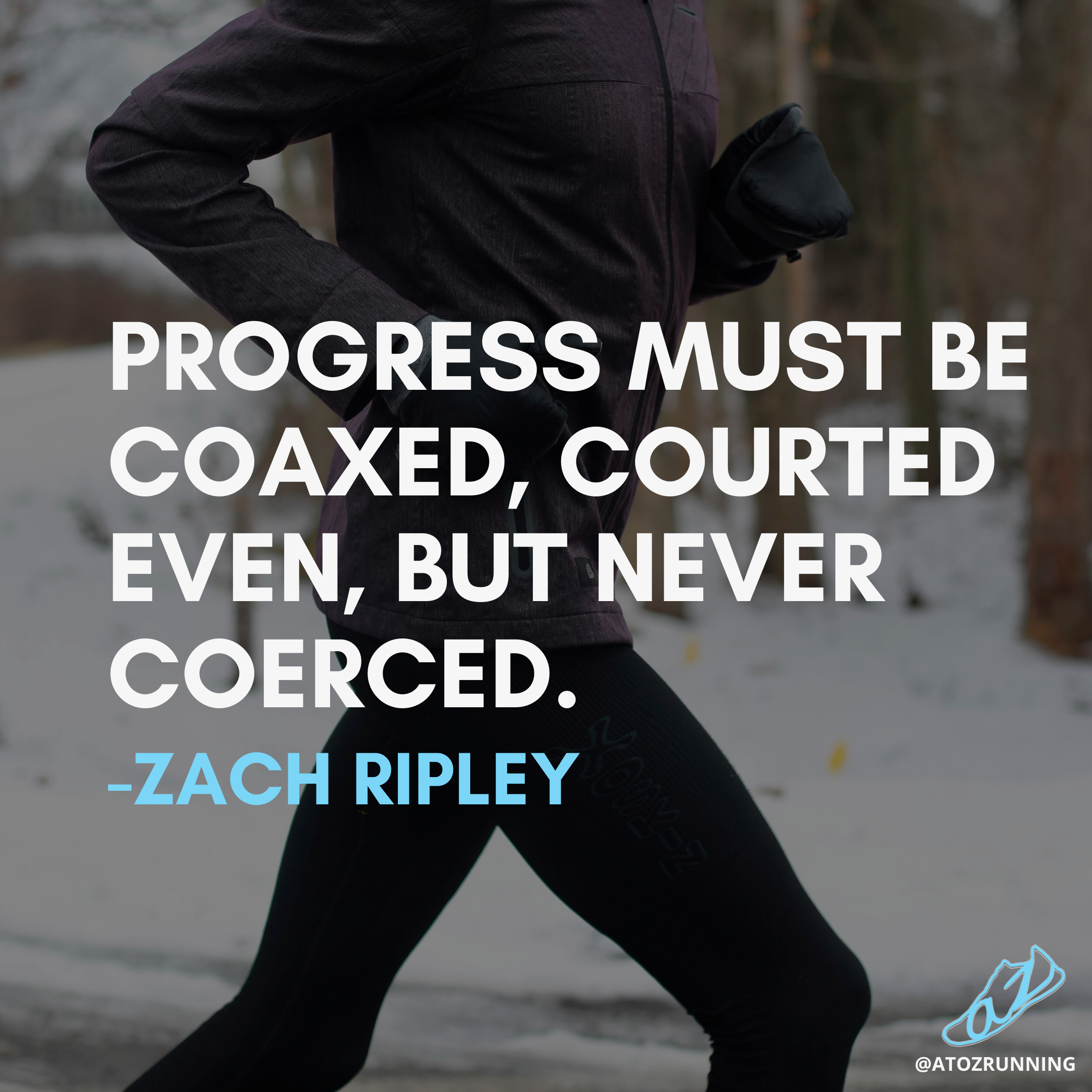by Zach Ripley, co-founder of AtoZrunning and Running Coach
Every runner wonders about how to run longer, whether in pursuit of longer races like marathons, ultra marathons, and beyond, or in pursuit of increased training potential. And we all tend to qualify the question. How to run longer without getting injured. How to run longer in the heat. How to run longer in workouts. You get it!
You know from our podcast or other articles that we like to try to simplify these kinds of things, and this question is no exception. But before we share the two word answer to this question, let me briefly share what we’re trying to do here.
This article is merely the first in a series we will be publishing on How to Run. The ultimate goal of the series is to establish how to run better (also the title of the final installment), and to get there, we plan to focus on the most basic aspects: running longer and running faster. More specifically, running longer and running faster effectively.
 The two-word answer to how to run longer
The two-word answer to how to run longer
Run easier.
As far as we can tell, every authoritative source on running agrees on this point. So it’s a good answer. But it’s also not very well followed.
Have you ever set out for a run to find in the final third or so that you don’t have quite the energy to finish what you started (or perhaps that you do, but you’re wondering if you’re going to pay for it later)?
We all have. Even so, we find ourselves regularly falling into this trap.
Here’s the first problem: we think things to ourselves like “8:30 is my easy pace, and since I do that for my easy 5 mile runs, I should do that for my easy 10 mile runs.” That may not be a conscious thought, but it is a common one. And falls apart under the weight of reality. We don’t run the same pace for a 10k and a half marathon race, so why would we run the same pace for an easy 6 or an easy 13 miles?
We wouldn’t. Not if the intended training stimulus is similar.
How much easier?
How much easier, then, is the first side of this coin, and while a whole lot of smart number crunchers have come up with clever ways of explaining this with heart rate and pace estimators, etc., such metrics are handicaps to the more essential need. We simply need to teach ourselves to run easy enough to finish the effort in the desired state.
If I’m trying to get through an easy run, I need to finish feeling like I’ve got plenty more to give and am not doubled over. If I’m trying to get through a strong effort or a race, I need to be able to run as strong in the last 25% as I could have run in the first 25%.
One simple guiding principle makes all the difference here. When in doubt, ease up. From a purely pragmatic standpoint, almost nothing is lost in training adaptations by going a little bit slower on a run, be it an easy effort or something harder. Conversely, much is lost by overdoing an effort, especially a long effort, especially when done repeatedly over time.
Always remember that progress must be coaxed, courted even, but never coerced.
How much longer?
In order to know how much easier to run, though, we also must know how much longer to run. These two are answered largely at the same time, but there’s at least some sound wisdom we can apply that does not require trial and error.
- Increase incrementally
- Master one step at a time
- Change one thing at a time
To describe these, let’s think in terms of distance and pace. But understand that we do not at all condone training by distance and pace. Effort and time are much more effective, especially at achieving the goal noted here.
First, incremental, linear increases are both the safest and most effective. If I’ve never run more than 5 miles before, I should probably run 7 or 8 before I try 10. In training, this means being patient and taking the necessary time to grow.
Second, use previous experiences to determine next steps. Never take a new step until the previous step has been successful. If I’ve run 8 miles but felt terrible in the last couple, I should not try to run 10 miles next but run 8 miles again.
Finally, change only one aspect of training at any one given time. Do not increase distance while also increasing pace or effort. If I am comfortable running 8 miles at 9:00 pace, I should try to run 10 miles at 9:15 pace (or something like that) before trying 10 miles at 9:00 pace. This is not a perfect science and never applies equally in all contexts, but it is a helpful guide when considering what the next step looks like.
Understanding WHY to Run Longer
In the previous comments, we raise a separate question. Is the intended training stimulus the same for longer runs as shorter runs? Of course, that depends. But assuming the most common scenario, longer runs are basically the most effective method for achieving the primary goal in training: growing aerobic capacity.
This being true, the logical conclusion should be that we ought to run long all the time. However, since that is not physiologically sustainable (let alone life and sanity and all that), we seek a more optimal balance of longer runs some days and shorter runs other days.
The traditional model of a weekend long run is entirely a product of convenience, but since most of us need to operate in that structure, the common recommendation tends to be thus.
Whatever the balance, there is more to understand about why longer runs have unique benefits over shorter ones and how to best achieve those benefits.
The physiology of running longer
As Dr. Todd Buckingham discussed in our conversation on “The Science of Building Fitness”, the physiology of running amounts to basically three things:
- System development (let’s call this energy, respiratory, and cardiovascular)
- Neuromuscular development
- Musculoskeletal development
All three of these areas are being developed at all times when running but to greater and lesser degrees depending on the type of effort and workload. This is where intelligent training plays a role because depending on the individual athlete’s goals and needs, different physiological aspects ought to be developed in different ways. For instance, a 200-mile ultramarathoner needs an overabundance of musculoskeletal development but does not require as much emphasis on neuromuscular development. Contrast that with a 5k runner who does not need as much musculoskeletal development.
Arguably, the greatest value Jack Daniels brought to the world’s collective running schema was the idea that any runner truly needs to develop every aspect to be successful. But not to equal degrees, and certainly not all at the same time. This last note is not universally shared, though perhaps it should be.
Many claim that runners should be training all three focuses simultaneously. Daniels even suggests as much, though not the extreme that some attribute. All the same, it’s quite obvious that certain aspects build on others. Namely, very little good is ever accomplished in trying to train aerobic systems without a strong musculoskeletal foundation.
Think structural integrity. No one builds a house on straws. No one builds a skyscraper out of paper mache. No runner should build energy systems on a weak structure.
As we pursue increasing load, we focus first on ensuring the structural integrity to handle the load. This is why, as noted above, we start with very easy efforts and don’t begin increasing the effort until we are able to easily handle the lesser effort.
We need to approach energy systems in the same way. Increases in volume with no change in effort still signal greater energy system adaptations by the change in duration. In every instance, efforts need to remain low so long as volumes are increasing. Further still, the longer the run, the lower the effort ought to be. Why? Because to best benefit from longer runs, we need to be doing them as often as our bodies can safely handle. This means doing so at a low enough effort that significant recovery time is not necessary before the next quality run (even if it is only more easy running).
Finally, increasing running volume also increases the need for economical neuromuscular activity. While such work is less noticeable on an easy 2 hour run than on an all-out mile race, the importance often lies most in economy achieved by regular varied neuromuscular stimulation.
So basically, just run easier.
Yep. A great many runners have been known to suggest things like, “I can’t run more than 2 hours for my long runs without getting hurt.” or “I can’t run over 55 miles a week without getting hurt.” But does it strike anyone else as a little silly to think that a person can regularly run 2-hour long runs but can’t handle 2 hours 15min? And if 2:15 is manageable, why not 2:30?
You see the point.
Understanding how the body adapts to a training stimulus and what it takes to maximize those adaptations is the key. As with everything in running, it isn’t so much an issue of whether to do the thing as it is how, when, and why do the thing.
THRIVE AS A RUNNER
A to Z Running is a website, coaching, and podcast that gives information about the world of running, inspiration to fuel passion and excellence, and ideas for making connections and finding community.
If you want to THRIVE as a runner, subscribe for FREE. Add good things to your inbox to help you become a better runner.



 Frank O'Brien
Frank O'Brien
Leave a Reply
Want to join the discussion?Feel free to contribute!